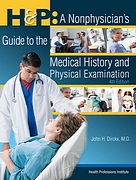Quiz - Week 32
1. Another name for varicella is
a. rubella
b. rubeola
c. chickenpox
d. smallpox
2. An acute, life-threatening disease of childhood is
a. diphtheria
b. chickenpox
c. rubella
d. rubeola
3. Lyme disease is caused by
a. erythema chronicum migrans
b. Clostridium
c. Borrelia burgdorferi
d. Orthomyxoviridae
4. Tetanus is also known as
a. herpes virus
b. chickenpox
c. lockjaw
d. rubeola
5. Tetanus is caused by
a. a bacterium found in the soil
b. Borrelia burgdorferi
c. Orthomyxoviridae
d. varicella-zoster virus
6. Children and teenagers with influenza should NOT be treated with which of the following?
a. bed rest
b. aspirin
c. analgesics
d. antipyretics
7. Which of the following diseases is characterized by macules, papules, vesicles and crusts?
a. measles
b. mumps
c. rubella
d. varicella
8. The most useful definition of pain may be
a. a sensation of hurting or strong discomfort
b. mental or physical distress or suffering
c. whatever the patient says it is
d. the body's way to warn of a more serious injury or disease
9. Surgery to relieve pain may include hypophysectomy, neurotomy,and
a. neurectomy
b. cordotomy
c. laminectomy
d. diskectomy
10. A therapeutic procedure to relieve pain in which electrical impulses are induced in large nerve fibers to block or reduce painful impulses is
a. biofeedback
b. electroencephalography
c. TENS
d. EMG
11. Medications for relief of pain may include all of the following except
a. narcotics
b. analgesics
c. anesthetics
d. antibiotics
Study Tip - Week 32
Researching Phrases The CD is new for this edition. It features: o Review and Summarize Just $34. Order today!
All of HPI's word books contain phrases cross-referenced under key words in the phrase, and some word books by other publishers do as well. However, if you cannot verify the phrase you're looking for in a word book, there is another option--the Internet. However, this option requires you to proceed with caution. The Internet is like the wild, wild West--lawless and vast. Before using the Internet for any kind of research, you should learn how to evaluate the reliability of your source. A Google search for "Evaluating Internet Resources" without the quotation marks will lead you to a number of excellent articles on the subject.
So, assuming you know how to evaluate the authority and accuracy of your source, how do you research phrases that you cannot find in your print references? Put key words surrounding an unknown word into the Google search box. If you have an exact phrase that you're fairly certain of, you can put the phrase in quotation marks. Scanning the results, you may find the phrase you're looking for just in the citations. If that doesn't work, click on the first few individual citations and scan those. This doesn't always work, but many times it will.
You can perform the same type of search at http://www.ncbi.nlm.nih.gov. This is the search site for the National Library of Medicine, and it will search thousands of medical journals for the phrase you need. This site, however, will not bring up as many options as Google will when your search terms are more nebulous. If you have an exact phrase (use quotations around an exact phrase to start with), however, this is an excellent resource. When the results are returned, use the Display drop down box that says "Summary" to choose Abstract. Generally, you can find what you need in the abstract and will not need to see the entire article. Space limits discussion of research techniques specific to this site, but you can click on the little question mark in the upper right-hand corner for Help to learn how to maximize your use of this wonderful resource.
4th ed. of H&P: A Nonphysician's Guide . . . with audio files on CD!

The 4th edition of H&P: A Nonphysician's Guide to the Medical History and Physical Examination, is now shipping with exercises and answers plus audio dictation clips on a CD! This book:
o Pause and Reflect
o Relate and Remember
o Collaborate and Share
o Explain and Learn
o Relax and Play
o Generalize and Apply
o Compare and Contrast
o Extrapolate and Project
Answers to Quiz - Week 32
1. Another name for varicella is
a. rubella
b. rubeola
*c. chickenpox
d. smallpox
2. An acute, life-threatening disease of childhood is
*a. diphtheria
b. chickenpox
c. rubella
d. rubeola
3. Lyme disease is caused by
a. erythema chronicum migrans
b. Clostridium
*c. Borrelia burgdorferi
d. Orthomyxoviridae
4. Tetanus is also known as
a. herpes virus
b. chickenpox
*c. lockjaw
d. rubeola
5. Tetanus is caused by
*a. a bacterium found in the soil
b. Borrelia burgdorferi
c. Orthomyxoviridae
d. varicella-zoster virus
6. Children and teenagers with influenza should NOT be treated with which of the following?
a. bed rest
*b. aspirin
c. analgesics
d. antipyretics
7. Which of the following diseases is characterized by macules, papules, vesicles and crusts?
a. measles
b. mumps
c. rubella
*d. varicella
8. The most useful definition of pain may be
a. a sensation of hurting or strong discomfort
b. mental or physical distress or suffering
*c. whatever the patient says it is
d. the body's way to warn of a more serious injury or disease
9. Surgery to relieve pain may include hypophysectomy, neurotomy,and
a. neurectomy
*b. cordotomy
c. laminectomy
d. diskectomy
10. A therapeutic procedure to relieve pain in which electrical impulses are induced in large nerve fibers to block or reduce painful impulses is
a. biofeedback
b. electroencephalography
*c. TENS
d. EMG
11. Medications for relief of pain may include all of the following except
a. narcotics
b. analgesics
c. anesthetics
*d. antibiotics
